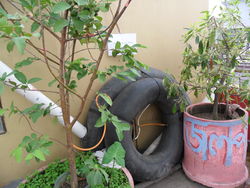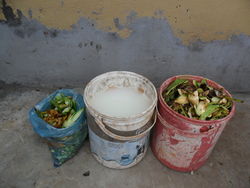TyreTube Biogas Plant
Overview
Dhaka City (Bangladesh) is inhabited by an estimated 15 million people and around 3000 to 4000 tons of waste is generated by households every day.
The Dhaka City Corporation is the only formal organization responsible for waste management in the city and collects less than half of the waste. Out of the waste collected, 40-50 percent is disposed in the landfills and the rest left unattended on roadsides, in open drains, and locally dumped in low-lying areas (yes, they collect it and then obviously dump it on roadsides again…). This has a negative impact on the city’s environment as well as on the global climate since Methane gas is released from municipality waste which is twenty-one times more damaging than carbon dioxide causing air pollution.
Most biogas plants in Bangladesh and elsewhere are designed to make use of poultry droppings and animal manure as their main feedstock, and are therefore comparably big in size and only used in rural areas.
The need for a more efficient waste management in cities and the worsening gas situation in Bangladesh resulted in the idea to try out small biogas plants for urban use.
Presently the government of Bangladesh is not able to provide any new gas connections to households. Even already existing connections in Dhaka are shut down regularly due to gas shortages and some people are only able to use gas in the night! Therefore there is a good opportunity and demand for biogas plants in Bangladesh. In a multistoried building rooftop tube-type biogas plant can help to improve the waste management, produce biogas and organic fertilizer which could be used in rooftop gardening.
Approach
The intention is to capture gas from household (kitchen) waste in small and affordable anaerobic biogas plants with low space requirements. The developed tube-type rooftop biogas plant is best run with kitchen and food waste for methane production. Kitchen waste as feedstock has a higher energy density compared to manure and digestion takes place rapidly. So a smaller quantity of decomposing material needs to be held in the plant. 2-3 kg (dry matter) kitchen and food waste feedstock produces about 1 m3 of biogas, whereas 28 kg of cattle dung feedstock is needed to produce the same quantity of gas.
Handling of the Plant and Waste
The wet organic material (kitchen waste and food waste) is collected in bins and containers brought to the rooftop. The waste is then mixed with water (twice daily 1kg of kitchen waste with 2 litres of water) and directly charged into the inlet of biogas digester, where bacteria breaks down the material and releases biogas. A rubber pipe connects the biogas digester to the gas stove, where it is used for cooking. The outlet from the biogas digester lets out the very watery slurry, which can be used as organic fertilizer. A pressure gage is used to monitor the pressure of the biogas that is available for cooking purposes. A hydraulic chamber is not applied. Instead the plant is pressurized through weight on the gas holder. The biogas plant has the capacity to hold 1.0 m3 gas and is able to provide enough biogas to cook for 1.5 hours (in total) per day and produces best quality organic fertilizer.
Specialty of this Roof Top Biogas Plant
A big plus for this type of plant is the fact that the core parts can be made out of recycled materials. In this case rejected tractor tubes have been used for the digester and gas holder. Piping, gas valve, pressure gauge and stove had to be bought. The total cost of the plant material was $60-70. Assembling time was only about thirty minutes(!).
The empty biogas plant weighs around 15 kg and can be transported easily.
Contact Zobayer for any question
Other Small Urban Biogas Systems
(ARTI-type) stacked barrell plants






















